At HomeQuestionsAnswered, we're committed to delivering accurate, trustworthy information. Our expert-authored content is rigorously fact-checked and sourced from credible authorities. Discover how we uphold the highest standards in providing you with reliable knowledge.
What is a Flush Valve?
A flush valve is a mechanism used to flush a toilet or urinal. The valve and associated hardware are located within the toilet tank or in the body of the urinal. Most toilets have a lever or push button activator, which is used to operate the flush valve.
A standard flush valve uses a rubber flapper to hold fresh water within the toilet tank, though some older models may use a ball rather than a flapper. As the user flushes the toilet using the lever, a chain connected to the lever raises the flapper at an angle. When the flapper is raised, the fresh water from the tank rushes down into the toilet bowl. This forces the existing water and waste material down through the S-shaped pipe at the base of the toilet.

Once the tank is empty, the flapper falls back into position over the opening between the tank and the toilet bowl. A separate refill valve allows fresh water back into the tank, where it will be stored until the flush valve is activated once again. While there is no limit to the number of times the flush valve can be activated in a given time period, the toilet will not flush unless there is enough water in the tank to fill the bowl.

Many problems that occur with these valves are very simple to fix, and can be easily repaired by the average homeowner. If the valve doesn't activate when you press the lever, it's possible the chain has become disconnected from the flapper. Remove the lid of the tank and reconnect the chain to remedy this issue. If the toilet seems to run continuously, the flapper is likely not closing all the way. Try shortening the chain slightly so the flapper can lay flat, or replace the flapper entirely if the edges are frayed or damaged.

Many modern commercial toilets use a flushometer instead of a standard flush valve. These toilets do not require a tank, so water enters the bowl directly from building's water supply piping. When the toilet is flushed, a special one-way valve is opened to bring fresh water into the toilet bowl. There is no way for waste to exit back through the water piping, so it is flushed out through the standard drain pipe. While these units take up less space than standard toilets, they are also fairly inefficient due to the large amount of water required for flushing.
AS FEATURED ON:
AS FEATURED ON:














Discussion Comments
@David09 - I’d like to see this wonderful flushometer that the article is talking about. I think it would solve at least some of the embarrassing problems you describe, namely the backwash of waste products back into the toilet bowl.
I really think that most modern households need to get with the times when it comes to toilet bowl technology. I’ve heard that in Japan they have some sophisticated jet stream technologies which, coupled with their high end electronics, give new meaning to the term restroom.
The closest I’ve come to anything sophisticated here in the States is the electronic urinal flush valve I see in some men’s restrooms.
I don’t touch any levers. I just walk away, and then this sensor trips and the toilet is flushed. I think we need more space age science brought to our most basic of amenities, like toilets.
@Mammmood - It’s strange how much of your peace of mind can be affected by how well the toilet works.
What you’ve described is not the worst scenario, however. The worst scenario is when you’re at a neighbor’s party, have to use their toilet, and it doesn’t flush - or worse, it overflows.
Then you have a problem, and you have to sheepishly whisper to your host that something is wrong, with the risk that they will see the wonderful waste products that you have deposited into their commode.
Of course, you know it’s not your fault, but that doesn’t take away the sting of embarrassment from the episode. I had it happen to me once and only once.
Thereafter I made it a point to go to the bathroom before attending anymore parties, and leaving before I had to go again. It’s an extreme practice I suppose, but well worth it.
I left the bathroom the other day and heard the familiar sound of the tank filling water after a flush.
Normally I put these sounds of out my mind. They’ve become background noise. However, ten minutes later, I still heard the sound. Sure enough, the toilet flush valve had not closed properly.
I lifted the tank, stuck my hands in and repositioned it. Within seconds the tank was full again and my life was restored to normalcy.
Post your comments